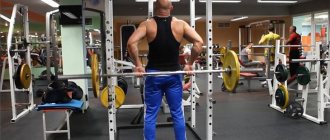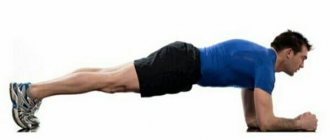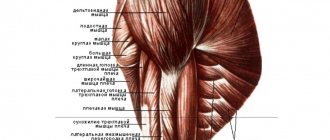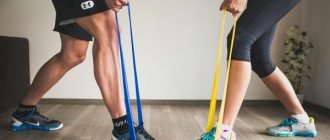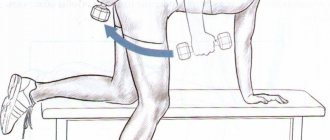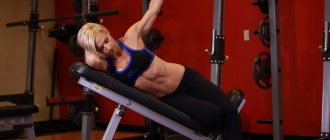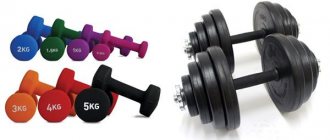Do you want to wear a sleeveless T-shirt, but can't afford it due to underdeveloped shoulder muscles? You just need to pump up your deltoid muscles. There is nothing cooler than voluminous shoulders!
Want to know how to pump up your deltoids in the gym? How many sets and repetitions will help pump up the deltoid muscles? Which split is best for creating harmonious shoulders? Let's take a closer look and find the perfect workouts!
It is important to understand that we are all different and react differently to the same stress. The deltoids are no exception. Here you will find several programs that serve different purposes.
Sets and reps for pumping up delts
What volume of sets and reps do deltoids respond best to? The deltoids are a small muscle group, so there is no need for a large number of sets. The average option is suitable.
Optimally – 10 approaches per workout. It's not too much and eliminates the risk of overtraining, but you can still lift enough weight and maintain the intensity.
In addition, you will be able to recover better. Since the deltoids are small muscles, they get tired faster. Not many people can do 20 sets of delts without overtraining.
If you are weak in training, perform basic exercises at least 8 repetitions per set to stimulate muscle growth. The exception is isolating exercises, for example, swings - 10-12 repetitions will be optimal for them.
Lack of elbow control when raising dumbbells to the sides
In this single-joint exercise for the middle delts, you extend your arms out to the sides to just below your shoulders. There are two ways to get to the top phase of the amplitude, but only one is effective for working the target muscles.
Let's start by considering the role of the middle deltas. When they are tense, the forearm rises to the side and up, activating the abductor muscles of the shoulder. The best exercises for the middle deltoids are also chin rows and overhead presses. When performing them, just watch the movement of your shoulders.
The mistake here is to lower your elbows and raise your hands. In this position, the shoulders do not go through the full range of motion, even if the palms in the upper phase are where they are supposed to be.
Keep your elbows low and your forearms parallel to the floor at the top of the rep. The movements should resemble a wide, sweeping arc, and for this you need to keep your elbows high. This is how the middle deltoids are activated.
Bodymaster.ru recommends Training Plans:
Often the deltoids are trained after larger muscles such as the back or chest. This means that all the energy will be directed to the first group, and nothing will be left on the shoulders. To stimulate growth, a high level of intensity and concentration is required.
The ideal option is to pump up the deltoid muscles on a separate day. This way the intensity will remain high and you will be able to lift more weight. The muscles will be fresh and easily respond to the impact.
Training the deltas in this program allows you to work on the trapezius. They don't require a lot of work, and the various variations of shrug exercises won't tire out your muscles. It is better to work on trapezius after deltoids.
Alternatively, the deltoids can be trained together with the quads and calves. This is a good option - the shoulder muscles will not get tired from working on the legs.
Biomechanics
The front bundle of deltas is included in the work when raising your arms in front of you , as well as in pressing movements . For example, with a classic bench press. It is for this reason that the front head of the deltas is usually well developed in most athletes and, compared to the front and rear, should be given a little less attention.
In accordance with the principle of biomechanics of the work of the shoulder muscles, almost all exercises for the front delts in one way or another include raising the arms or various types of presses.
Training to pump up deltoid muscles
Are you new to the gym and want to have beautiful shoulders? Or have you made yourself at home in the gym, but your deltoids are still underdeveloped? Then check out these two effective workouts!
Basic training
This delt pumping workout is designed for beginners. Duration - 40-50 minutes. At first, do exercises with a barbell. Once you are comfortable with the technique, you can start working in the Smith machine, then you can move on to free weights.
Lowering the head while raising the shoulders with dumbbells
This is a detail that you probably never paid enough attention to. But in vain! Because incorrect head position when performing shoulder lifts can cause injury to the cervical spine.
The face should be facing forward. If you lower your head, your cervical spine will be in a flexed position. When lifting heavy weights (as usually happens when training the upper trapezius), additional stress will be placed on it, which can lead to a hernia. This can result in serious problems such as tingling in the hands, weakness and atrophy of the affected limb.
To prevent such negative consequences, control each repetition. Always look straight ahead or use a mirror to check.
Workout for Beginners
Perform once a week.
Standing barbell press (or Smith machine)
- 4 sets of 8-10 reps
- Body part: Shoulders Equipment: Barbell
Attention: 1st approach - warm-up (perform with less weight) 2, 3, 4 - perform with working weight Can be performed both sitting and standing, or alternate between weeks
Standing overhead press
- 4 sets of 10-12 reps
- Body part: Shoulders Equipment: Barbell
Attention: 1st approach - warm-up (perform with less weight) 2, 3, 4 - perform with working weight
Standing dumbbell lateral raises
- 3 sets of 10-12 reps
- Body part: Shoulders Equipment: Dumbbells
every week, alternate position 1 training sitting, second standing, third – bent over swings.
Add to Calendar * Add to My Workouts * Print Workout
* — The service is in beta testing
Advanced training
If you consider yourself an experienced athlete, choose high-volume training. This program calls for more sets and a slightly higher rep range. The exercises are structured in such an order to avoid fatigue that occurs with large volumes of work.
Contraindications
Invented by Lee Haney, the exercise is performed standing with a barbell or dumbbells. Moreover, the sports equipment is located behind the back. All this leads to an axial load on the spine.
In order for the bar to move freely along the buttocks and back of the thigh, you need to lean back slightly. Because of this, the load on the lower back increases.
Why am I telling this? And the spine and our shoulder girdle must be healthy, otherwise cravings should be avoided.
In particular, you should avoid it if you have diseases of the elbow and shoulder joints and osteochondrosis.
Pump up your deltoids. Workout 1
Bench press with a wide grip lying on a horizontal bench
- 4 sets of 8-10 reps
- Body part: Chest Equipment: Barbell
Incline Dumbbell Press
- 4 sets of 8-10 reps
- Body part: Chest Equipment: Dumbbells
Lifting hands with dumbbells while lying down
- 3 sets of 10-12 reps
- Body part: Chest Equipment: Dumbbells
Standing dumbbell lateral raises
- 3 sets of 10-12 reps
- Body part: Shoulders Equipment: Dumbbells
Vertical barbell pull
- 3 sets of 10-12 reps
- Body part: Shoulders Equipment: Barbell
Add to Calendar * Add to My Workouts * Print Workout
* — The service is in beta testing
Pump up your deltoids. Workout 2
Pull-ups
- 4 sets of 8-10 reps
- Body Part: Lat Equipment: Bodyweight
Bent-over barbell row
- 4 sets of 10-12 reps
- Body Part: Press Equipment: Barbell
Bent-over dumbbell row
- 4 sets of 10-12 reps
- Body part: Middle back Equipment: Dumbbells
Dumbbell flyes lying on an incline bench
- 4 sets of 10-12 reps
- Body part: Shoulders Equipment: Dumbbells
Dumbbell one-arm bench press
- 4 sets of 8-10 reps
- Body part: Chest Equipment: Dumbbells
Add to Calendar * Add to My Workouts * Print Workout
* — The service is in beta testing
How to pump up deltoids in a split
In most cases, deltas are not given enough attention. It can be difficult to dedicate a day exclusively to this muscle group. However, like other important muscle groups - legs, back, chest - the deltoids also require separate training.
If you decide to do split training, first familiarize yourself with its concept in order to correctly select exercises and determine the number of days. If you combine deltoids with other muscles, start training with deltoids. If you think that another muscle group is more important, then start with it.
If you combine pumping up the deltoids with your back, then it is advisable to start with the posterior part of the deltoid muscle (variation: you can start with the middle one). This is justified by the fact that if you hit your shoulders first, you won’t be able to fully load your back. Train the big muscles first, then the small ones. Below is a four-day split training program for advanced athletes.
When is it worth purchasing a Delta 3D printer?
When choosing a printer, decide what you want to get from it. Printers with Cartesian kinematics are often supplied assembled and work out of the box. In addition, they are more popular and have a fairly large community formed around them.
Delta printers are often supplied in the form of assembly kits and are printed by fewer makers, that is, there is correspondingly less information about them on the Internet. Their advantage is printing speed and low noise level - if these qualities are important to you, you should consider purchasing a delta bot. It should also be preferred if you are going to print mainly vertical objects.
Bodymaster.ru recommends Fitness Trainers:
If you don't want to give up big delts, there are ways to pump them up in this case too. You will have to work with lighter weights. This means more prolonged muscle tension, negative repetitions, precise technique, or strengthening the mind-muscle connection. These methods compensate for low weight and have a positive effect on muscle growth. You will work the target muscle and feel it work even better than with heavy weights. You'll be surprised how hard it is to lift moderate weights while maintaining strict technique.
So, here are the basic tips that will help pump up the deltoid muscles when injured:
- Develop a program based on isolation exercises, such as alternating dumbbell front raises, standing dumbbell raises, and lat raises. You will work to failure with less weight, while muscle growth will continue and the injury will not get worse.
- Work in high rep ranges. This doesn't mean lifting one-pound dumbbells. Typically, more reps with lighter weights are performed in the warm-up, but you can follow this in the main part.
- Don't forget that the deltoids are involved in training the back and chest, so control the pressure of the weight.
Exercises for home
After all the pros and cons have been weighed, it’s worth moving on to the most important thing - the best exercises for the trapezius. First you need to see what you can do at home. But in fact, you can do a lot, in particular:
- shrugs with bags;
- pull-ups with the widest possible grip;
- reverse shrugs on stools.
That's all. Modest? Perhaps, but these trapezius exercises at home will help pump up the muscle well without going to the gym.
Home shrug technique
Before describing the technology, you need to select suitable shells. In order not to split hairs for a long time - and to make the exercise as cheap as possible in terms of equipment, you will need eggplants with water and strong bags.
One bottle contains 5 liters of water. To begin with, you need 4 eggplants and 2 bags, each of which can hold an eggplant.
Eggplants can be replaced with buckets or bags of books, but in this case there is a high chance of getting a weight imbalance, which will lead to imbalances and problems with the spine. Therefore, in the absence of accurate scales, water is the only option.
After the apparatus is constructed, you can begin the exercise. You need to take a working weight in each hand (to begin with, you can get by with 5 kilograms, then feel free to move on to 10 kilograms). Let's consider performing a trapeze exercise on a horizontal bar.
- Stand up straight with the equipment, without bending.
- Pull your shoulders up. It is important to pull at the elbow joint without bending your arms.
- Keep your head straight ahead.
- Do not rotate the shoulder joint.
- Hold at the top point for 2-3 seconds.
- Lower the projectile.
Due to the extremely low weight (the load capacity of the trapezius of an untrained person is about 32 kilograms), you can perform the exercise in the 5*20 mode. This exercise perfectly works the “always lagging” upper part, and even with such small weights you can achieve very noticeable progress.
Pull-up technique
Unfortunately, you can’t do without pull-ups and a bar. Of course, you can compensate for the middle by using reverse shrugs, but the overall lag will remain. Technique for proper pull-ups with a greater emphasis on the trapezius:
- The width of the grip is determined as wide as possible (ideally, a projectile with bent handles). On average, 2 palms wider than shoulders on each side.
- Hang on the bar, maintaining an even angle of your back without bending.
- Pull yourself up at a slow pace and touch the bar with your bottom chest.
As you can see, the technique of pull-ups with an emphasis on the trapezoid is somewhat different from the classic wide pull-ups. However, its effectiveness is relatively low.
Reverse shrug technique
The next exercise for the lower trapezius is, of course, best performed on the uneven bars, but even in their absence you can create conditions for progress. These reverse surface shrugs are the best exercise for the lower trapezius. How to prepare the projectile?
To do this, you will need two high chairs or tables - at least 50-60 centimeters high. They need to be placed parallel to each other, at such a distance that the body and arms can fit between them, separated by 15-20 degrees. After the apparatuses are fixed, you can begin the exercise for pumping up the trapezius:
- Hang between the shells. If their height is insufficient, bend your knees so that they do not touch the floor.
- Slowly lower your shoulders without bending your elbows.
- Rise as high as possible, without using your elbow joints.
- Fix at the top point for 3-5 seconds.
Thanks to your own weight, the load during the exercise on the back and trapezius will increase several times. Therefore, to begin with, it will be enough to do 3*10, with a gradual increase in load.
Unfortunately, all of the above exercises are only suitable for beginners, or for people whose back is very weak. To seriously pump up the trapezius and shoulders, you need exercises with serious weights. Therefore, there is nothing left to do but run to the gym for a month after pampering yourself.
How to eat to pump up your deltoids
Nutrition is an important part in building the body of your dreams, which means that while working on deltoids you should closely monitor your diet. Consume more complex carbohydrates (rice, buckwheat and other cereals) and protein-rich foods (meat, fish, eggs and cottage cheese). And sports nutrition will help your body pump up deltoid muscles and recover after training.
When training for a delt pumping program, remember that your body needs materials to build muscle. Healthy food and sports nutrition will help you achieve your ideal body faster!
Pumped delts look very impressive. Round and defined muscles will give you confidence. Follow the advice in this article and you will pump up deltas that will make you jealous!
Review of models - examples of Delta 3D printers
06.1. Mass Portal D300
The Mass Portal D300 professional series 3D printer has the largest build area in its series. Uses high-temperature open materials for printing. Designed to work with the best 1.75mm diameter thermoplastic filaments, printing in hot air temperatures up to 475°C. The design uses a water-cooled dual extruder.
- Dimensions: 480x620x855 mm
- Software: FabCloud, Simplify3D, FabControl
- Working chamber: 300x300x300 mm
- Travel speed: 250 mm/sec
- Printing technology: FDM
- Layer thickness: from 150 microns
- Supported materials: ABS, ASA, BVOH ,CPE, HIPS, PA (Nylon), PC, PEI, PEEK, PET, PETG, PLA, PMMA, POM, PP, PPSU, PVA, PVB, TPE, TPU
- Thread diameter: 1.75mm
- Nozzle diameter: 0.4mm
- Platform: heated
- Price: RUB 1,132,061 (The price is as of December 12, 2018. Find out the current price on the website)
06.2. 3DQuality Prism Pro Dual
The 3DQuality Prism Pro Dual 3D printer is a professional-level device. The work is facilitated by automatic calibration, and the heated working table and closed chamber guarantee protection of the product from deformation during printing, for example, ABS.
- Material: ABS, PLA, HIPS, FLEX, SBS, PVA
- Heated platform: yes
- Working chamber: Ø400x860 mm
- Travel speed: 200 mm/s
- Printing technology: FDM
- Layer thickness: from 50 microns
- Thread diameter: 1.75
- Nozzle diameter: 0.6mm
- Display: LCD screen
- Interfaces:Wi-Fi
- Number of print heads: 2
- Price: 364,650 rub. (The price is as of December 12, 2018. Find out the current price on the website)
06.3. Delta WASP 2040 Clay
DeltaWASP 2040 Clay is an indispensable tool for those working in the field of 3D ceramics. Accurate and fast, supports all ceramic materials. The Clay 3D printer is open and accessible on three sides for interaction while printing. Compact professional clay 3D printer that produces prints up to 40 cm in height.
- Dimensions: 490x440x870 mm
- Working chamber: Ø200×400 mm
- Travel speed: 150 mm/s
- Printing technology: LDM
- Layer thickness: from 500 microns
- Supported materials: porcelain, faience, gres, refractory, clay
- Nozzle diameter: 1.2mm
- Interfaces: SD Card
- Print speed: 150 mm/s
- Price: 354,286 rub. (The price is as of December 12, 2018. Find out the current price on the website)
